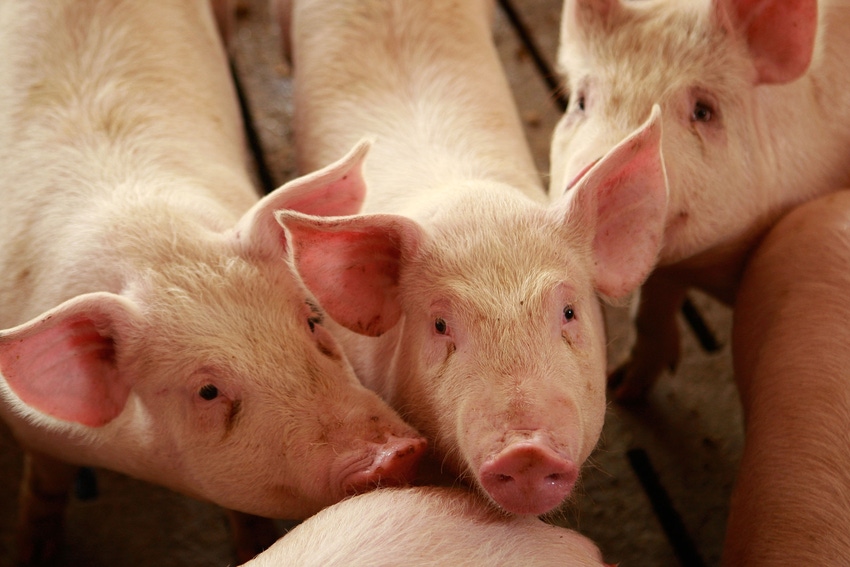Possibility of profitable hog prices in 2022 if feed costs don’t rise too high.
April 6, 2022

USDA’s March “Hogs and Pigs” report revealed the March 1 inventory of all hogs and pigs at 72.209 million head, down about 3% from the previous quarter and 2.3% from March 2021. Pre-report analyst estimates expected the inventory to be only 1.2% lower. Western Illinois University economist Jason Franken said the market hog inventory is about 2.4% smaller than a year ago, compared to expectations that the inventory would only be 1.3% lower. While all hogs and pigs and market hogs fall within anticipated ranges of around 0.5% to nearly 3% lower for both, the breeding herd, the December to February pig crop, and farrowing intentions from March to May and June to August are all somewhat lower than expected, he said.
“For instance, the breeding herd is 1.9% smaller, compared to expectations that it could be up 0.1% with a range of 0.6% lower to 0.5% higher.”
Further, Franken said each class of market hog inventories is down compared to the same time last year. The heaviest two weight classes of 120-to-179-pounds and over-180-pounds are about 3.5% and 3.8% lower, respectively. Meanwhile, the under-50-pound class and 50-to-119-pound class are about 1% and 2% lower than last year, compared to expectations of about 1% higher and 0.5% lower, respectively. Overall, the number of hogs weighing less than 180 pounds is around 2% smaller than a year ago, and these will be the market hogs arriving at processing plants from April to August.
Franken said the decline in lighter weight hogs partly reflects that with around 1% fewer sows farrowed and pigs per litter essentially even with last year, the December-February pig crop is almost 1% smaller than a year ago—well below the anticipated range of 0.4-2.6% higher. Market hogs from this pig crop will arrive at processors from June to August. On a monthly basis, the last time pigs per litter exceeded the prior year was last December, noted Franken. Meanwhile, spring and summer farrowing intentions are down 1.5% and 0.6%, respectively, from actual farrowings last year.
�“These numbers should similarly imply somewhat smaller slaughter in subsequent periods,” Franken said.
Cold stocks of meat also remain low, Franken pointed out. The USDA “Cold Storage” report showed cold stocks of pork on February 28 are up 11% from the previous month but down 1% from a year ago. Poultry stocks are up 6% from the prior month but down 1% from last year, while beef is up 1% from the prior month and 1% from a year ago.
USDA forecasts U.S. per capita pork consumption in 2022 at 51.2 pounds per person. Prior to COVID-19, Franken said U.S. per capita pork consumption reached 52.4 pounds in 2019, the highest it has been since it was 54.2 pounds in 1981.
In January, the U.S. exported 510 million pounds of pork, about 16% less than in January of 2021. While this decline largely reflects shipments to China and Hong Kong decreasing by 70%, Franken said exports to Mexico increased by about 49%.
Based on generally weak demand from major pork importing countries, USDA estimates total U.S. pork exports for the first quarter of 2022 at 1.58 billion pounds, about 18% below last year. Second and third quarter exports are anticipated to be about 14% lower and 5% higher than the prior year, respectively. Fourth quarter exports are expected to rise nearly 15% over the prior year to about 1.9 billion pounds.
Essentially, while pork exports are starting off lower in 2022, Franken said they should grow in the latter half of the year.
Taking all of this into account, "there is the possibility of profitable hog prices in 2022 if feed costs don’t rise too high."
Franken presented a price forecast using the national weighted average net price on a carcass basis for all transactions for producer-sold barrows and gilts, including negotiated and contract prices. This net price, he said, should be more reflective of what producers receive, on average, and normally runs at a premium of more than $2.00/cwt. over the base price on average. From December-February, this net price averaged $82.12/cwt. compared to $71.37/cwt. for the corresponding net prices for negotiated or spot transactions.
According to Franken, hog prices tend to be higher in the second and third quarters, with lower prices in the first and fourth quarters. The latest forecast is consistent with that pattern. The price averaged $90.24/cwt. for the first quarter of 2022 but rose in late March. Accordingly, Franken said second and third quarter prices are forecast to average about $104.96/cwt. and $104.64/cwt., respectively, with prices dropping to $91.04/cwt. for the fourth quarter of 2022 and $90.67/cwt. for the first quarter of 2023.
“These projections are consistent with the strong demand and lower supply observed currently, the effects of which may weaken somewhat later in the period if producers start to ramp up production. If hog supply turns out to be greater than anticipated or if demand falters, then lower prices may be realized.”
You May Also Like


.png?width=300&auto=webp&quality=80&disable=upscale)
